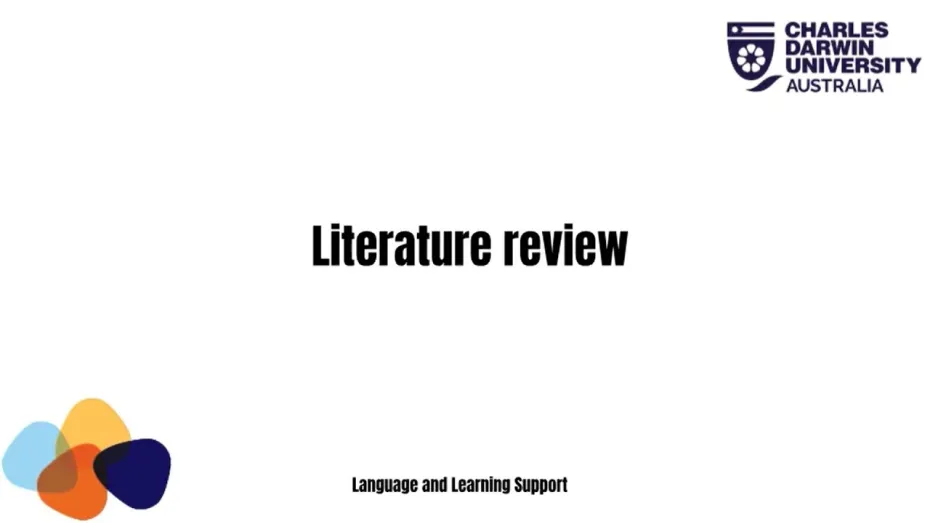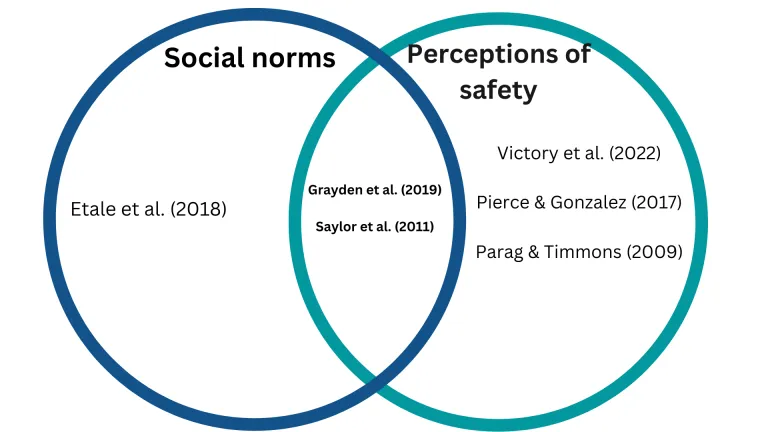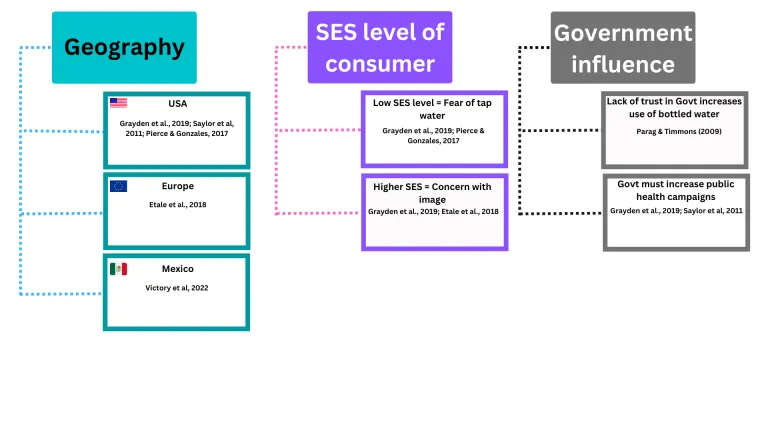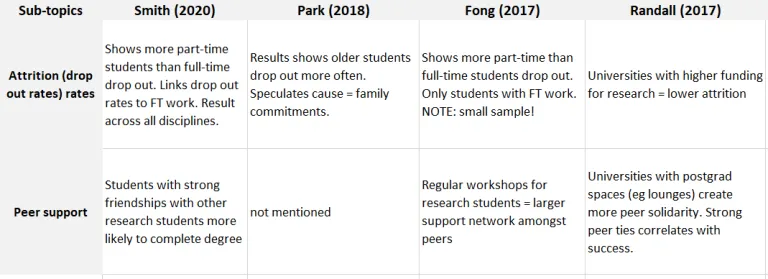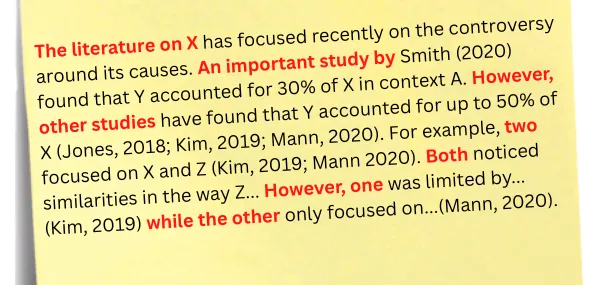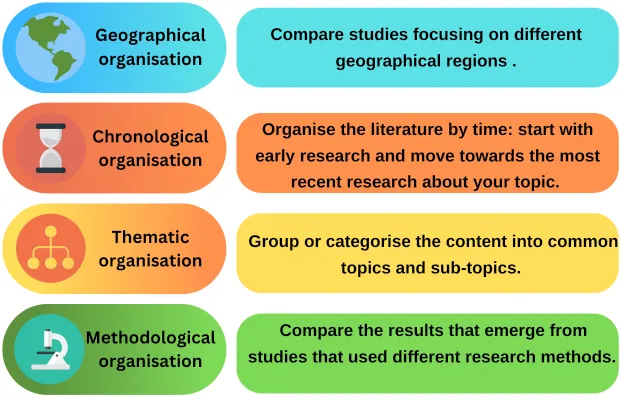All scholars refer to the work of other scholars in their writing. In this way, they participate in a type of academic conversation that helps to build knowledge in their discipline. As a student, you also participate in this conversation by referencing the experts in your field. Literature reviews are one type of assignment that develops your ability to do this.
This material aims to help undergraduate and postgraduate coursework students who need to write a short literature review as a university assignment. If you are a research student, visit Writing a literature review in Research Communication.
This page will help you to meet your lecturers'expectations by:
self-evaluating your current strengths and weaknesses
considering the purpose of literature review assignments
following logical steps to write the review
asking questions to evaluate the literature
organising notes for literature review assignments
structuring your literature review assignment effectively
choosing appropriate language to report on and critique literature.
Download this summary sheet for your own reference.
Introduction to literature review assignments
This section gives a simple overview of literature review assignments. It includes their purpose, a process for writing a review, questions for evaluating literature, and a method for organising your notes.
Self evaluation
Before you continue, reflect on your previous writing experiences and the feedback you have received. How would you rate your ability in the following skills? Rate your ability from ‘good’ to ‘needs development’.
Reflect on your answers. Congratulations if you feel confident about your skills. You may find it helpful to review the materials on this page to confirm your knowledge and possibly learn more. Don't worry if you don't feel confident. Work through these materials to build your skills.
An overview of literature reviews as an assignment
Learn more about literature reviews as an assignment by watching this video:
Reflect on what you have learned in the video about literature reviews as an assignment. Select the best sentence out of each pair to create a summary of the main points.
The purpose of literature review assignments
What's the difference between an essay and a literature review?
An essay examines a topic: you discuss the topic and the literature is used as evidence to support your ideas.
A literature review examines the literature of a topic: you discuss what has been published on that topic. In fact, we can say that the literature is the topic.
Before you begin your literature review, you should try to understand the purpose of the task.
Read the instructions carefully.
Consider how the task helps you meet the unit learning outcomes.
Consider how the task might help you to build your knowledge or complete later assessments.
Reflect: Why do you think your lecturer has set the literature review task? Is it:
a stand-alone assignment? Lecturers create these tasks to help you get to know the important literature in your field.
a step in a long project? Lecturers create these tasks to ensure you have understood the literature that you will need for a longer or more complex project later.
In brief, when writing a literature review, you must show your understanding of the literature.
Steps to writing a literature review
The following steps can guide you through the process of writing a literature review. You could download this PDF so you can tick off each step as you finish it.
Step 1
| Read the instructions very carefully to ensure you understand task requirements. You should check, for example:
|
Step 2 | Analyse the topic very carefully to ensure you understand the scope of the task. |
Step 3 | Conduct research to find potentially useful texts. The subject guides in the library can help you get started. |
Step 4 | Select appropriate sources. Visit the Library page on evaluating sources to help you. |
Step 5 | Record the bibliographic details of the sources you find. Use the required reference style to do this. If you are not sure which style is needed, ask your lecturer. |
Step 6 | Create a spreadsheet or matrix for your notes, so you can retrieve and compare your sources easily later. |
Step 7 | Evaluate and critically read the sources you have found. |
Step 8 | Make notes into your spreadsheet of the key points, the strengths, and the weaknesses of each source. |
Step 9 | Reflect on what you are learning from your reading. Ask yourself:
|
Step 10 | Use your learning and your reflection to categorise your notes under headings and sub-headings and write a plan for your literature review. |
Step 11 | Put the original sources away and use your plan and notes to write your first draft. |
Step 12 |
|
Organising your notes
One key to writing an effective literature review is to store and organise your notes effectively. This section will look at spreadsheets and visual organisers.
Using a spreadsheet
One way to organise your notes is to use a spreadsheet. The advantages of spreadsheets are that you can:
- choose your headings and refine them as you learn more about the topic
- use the search function to identify key words from common ideas in the texts
- include hyperlinks to the original documents.
Read these notes on a student spreadsheet for a literature review on attitudes to bottled water. Click on the hotspots to identify where the student has:
included the citations for each source
created columns to note important information such as method, findings and conclusions
included initial critiques of sources
noted where references share similar or contradictory ideas
started to note common concepts that can be used to categorise the references
Note-taking is quite personal; that is, you need to devise a method that works best for you. If you use spreadsheets, you may adapt your spreadsheet to the requirements of each assignment. Here is a spreadsheet that you can download and adapt:
Using visual organisers
When you are storing your notes, you could also experiment with visual organisers. These can help you to categorise and compare the literature. For example, you could use:
Venn diagrams
Notice how some of the citations from the spreadsheet for the literature review on bottled water are categorised in this venn diagram.
Tree charts
Notice how some of the citations from the spreadsheet for the literature review on bottled water are categorised in this tree chart.
Imagine you have found another source for a literature review on bottled water. Where would you put this source in the visual organisers?
Other visual organisers include flowcharts, time lines and mind maps.
Visual organisers are quite personal; that is, you need to devise a method that works best for you. If you use visual organisers, you should adapt them for each assignment.
Using a matrix
One way to find links between the papers you read is to make notes in a table or matrix. You can learn more about using a note-taking matrix from The Thesis Whisperer.
One student has researched the topic of success in post-graduate studies. They have created a matrix for storing their notes. A matrix is organised in this way:
- Each column is for an article that the student has read.
- Each row is for a sub-topic or idea.
In this matrix, the student has put notes about attrition (drop out rates) in row one. In row two, the student has put notes on peer support for students.
When the student wrote about attrition, they first read along the row. They compared the information, and noted how the different sources agreed or disagreed with each other. Then, they synthesised this information to create their paragraphs.
Over to you:
Here is a matrix that you can download and adapt:
Structuring your literature review
Like essays, your literature review will follow a standard thee-part structure: introduction, body and conclusion. The following section will help you organise each part.
Introducing your literature review
What do you know about writing introductions? Test your knowledge here:
Now, analyse this sample introduction.
If you need to review effective introductions, visit the Essays page.
Organising the body of your literature review assignment
Students who are new to literature reviews may write the body like a list of summaries. A list of summaries makes your review look like a shopping list of sources.
Remember: a literature review is not a list of summaries! You need to categorise, organise and synthesise the literature to write a coherent text that draws links between the research.
If you would like to learn more about this, visit the blog patter by Pat Thomson.
Some common organisational methods include:
Remember: these are not the only ways you can organise your literature review. You may combine these organisational methods or create a new method of your own.
This task contains images of content pages used in longer literature reviews, such as a thesis chapter. Your assignments will be shorter, but these images provide examples of different ways you could categorise and organise the literature in your review.
When you write the body of your literature review, you will use a range of skills and techniques.
| |
Paragraphing
| Like essays, the body of your literature review is divided into paragraphs that focus on one main idea presented in the same order as the introduction outline. If you need to review effective paragraphing, visit the paragraph page. |
Paraphrasing, summarising and generalising | To use your notes to discuss the literature, you will need to put them in your own words when you paraphrase, summarise and generalise. |
Referencing
| Be very careful with referencing. The referencing style that you use depends on the expectations of your lecturer, so always check first. |
Concluding your literature review
What do you know about writing conclusions? Test your knowledge here:
Now read this sample conclusion to identify the elements.
If you need to review effective conclusions, visit the Essays page.
Language for commenting on literature
If assignments that require you to comment on research (like literature reviews or annotated bibliographies) are new to you, you may be unsure how to express yourself. The following materials focus on clear and appropriate language choices.
Evaluating the literature
An important skill for writing literature reviews is the ability to critically evaluate sources. If you are unsure how to do this, ask yourself a series of questions to guide your thinking.
Selecting credible sources | The CRAAP test offers a series of questions about currency, relevance, authority, accuracy and purpose to help you choose good quality sources. Download and print this useful document from the CDU library so you can refer to the questions while you are researching. | |
Evaluating research | Introduction and literature review
Method
Results
Discussion and conclusions
| |
Over to you:
Review a text you have selected for your own literature review.
- Does it pass the CRAAP test?
- How would you evaluate the quality of the research?
Strategies to critique the literature
Some students feel concerned about critiquing literature. They confuse critique with criticism and think they don’t know enough to criticise published experts.
However, critiquing the literature is more than criticism. It involves strategies such as:
identifying important researchers or research papers
comparing and contrasting the research
identifying research with similar findings (or generalising)
identifying strengths or limitations in the research
showing how a research paper contributes to our knowledge
identifying gaps in our knowledge of a topic.
Read these literature review extracts and identify the critique strategy the student has used. Drag the number of the critique strategy next to the most appropriate extract.
This document has some useful language that may help you express these strategies in your own literature review. Download it and put it on the wall near your desk while you are writing.
Language for critiquing the literature: adjectives and verbs
When you are describing the strengths and limitations of a research paper, you must use appropriate adjectives and verbs. You should also consider their strength.
Imagine you want to select an adjective to complete this sentence:
In this ________ study on dolphins, Smith (2022) attempted to...
Categorise these adjectives according to their strength.
Now, imagine you want to select a verb to complete this sentence:
However, Smith’s study __________ the link between dolphin mortality and pollution (2022).
Categorise these verbs according to their strength.
Remember, you may make strong language choices, but you must:
- be careful to match the strength of the language with the strength of the praise or criticism
- always maintain a respectful tone.
Pay close attention to the language choices in published literature reviews in your discipline.
Verbs to report on research
When you cite the research in your literature review, you may use two citation types:
Research prominent | Humpback dolphins are generally shy and avoid boats (Johnson, 2018). |
Researcher prominent | Johnson (2018) states that humpback dolphins are generally shy and avoid boats. |
- In general, research prominent citations are most used. This is because our focus is on the research, not on who did the research.
- We use researcher prominent citations when we wish to mention the researcher. This may be because their work is particularly noteworthy, or it is important for your assignment. Researcher prominent citations are more common in the Humanities and Social Sciences than in the STEM disciplines.
If you use researcher prominent citations, you will use a reporting verb. These verbs describe:
Function | Example verbs | Example verbs in use |
goals | aim, intend, attempt | Van Dam and Cook (2001a) aimed to establish a link between vessel noise and acoustic communication between humpback dolphins. |
activity | discuss, investigate, study, focus on, explain, theorise | Van Dam and Cook (2001a) investigated the link between vessel noise and acoustic communication between humpback dolphins. |
results | show, reveal, demonstrate, indicate, suggest, state | Van Dam and Cook (2001a) have shown that vessel noise can have a negative impact on acoustic communication between humpback dolphins. |
opinions | argue, posit, believe emphasise, suggest, state | Van Dam and Cook (2001a) argue that vessel noise should be reduced in humpback dolphin territory. |
You may notice that some of the example verbs (like state) perform more than one function.
Your choice of reporting verbs can help you demonstrate your critique of the research. Read these two sentences. Which one shows most confidence in the results of the research?
The study by Anderson et al. (2017b) suggests the reduced distribution of humpback dolphins is due to habitat degradation.
Anderson et al. (2017b) state that the reduced distribution of humpback dolphins is due to habitat degradation.
Many readers would feel that b. shows the most confidence.
Read the following sentences and pay attention to the verb in bold. Can you identify the function and the level of confidence?
If you want more revision on reporting verbing, visit Useful language for annotated bibliographies.
Writing literature reviews and generative AI
While generative artificial intelligence (GenAI) can be helpful in writing a literature review—such as summarising articles, identifying key themes, and organising references—students must ensure that their analysis and synthesis reflect their own critical thinking. Relying too much on AI-generated content can undermine the purpose of a literature review, which is to engage deeply with existing research and offer original insights. Submitting work that doesn’t represent a student's academic engagement breaks academic honesty policies and reduces the chance of developing a strong, critical understanding of the subject.
Limitations of GenAI for writing literature reviews
GenAI has several limitations when writing literature reviews, which require careful analysis and critical engagement with existing research. Unlike simpler writing tasks, literature reviews need a deep understanding of the research context, methodologies, and scholarly debates—areas where AI may struggle. While GenAI can produce text that seems coherent, it often lacks the nuanced analysis and scholarly judgement needed for a meaningful literature review. This can lead to reviews that feel superficial or disconnected from current academic discussions, risking misrepresentation of the field and the student's academic voice.
Have a look at the task below, its marking rubric, and the sample provided. Do you think the sample addresses the task requirements and the elements in the rubric?
Now answer questions 1-4 below.
Click on the hotspots below to see all the issues with the AI-generated essay. Then compare it with a sample written by a student.
Prompts to help you get started with your literature review
Prompt engineering is a pivotal skill in leveraging AI effectively for academic and professional purposes. Clear and specific prompts, such as those focusing on outlines or research plans rather than final products, foster deeper engagement with the subject matter and uphold academic integrity.
See below some prompts to help you get started with your next literature review.
We also encourage you to review our study skills page “Using AI tools at university” and download the GenAI Quick Tips sheet to learn more about how to use GenAI effectively and ethically.
Applying your learning
Reflect on what you have learned in this material and consider how you can use it in your own work.
Avoiding common issues with literature reviews
When you write a literature review assignment, you may have some challenges. Common challenges include:
not knowing how to get started
feeling overwhelmed by the amount of reading you need to do
finding too much or not enough literature in your searches.
keeping track of the literature you find
not knowing how broad or how narrow to make your review
knowing which texts are relevant to the topic
knowing which researchers and texts are important in the field
not knowing how to organise the literature review
not understanding complex research articles.
Read this advice to help you manage your literature review successfully.
Advice for success
- Review the task instructions and reread your lecture notes.
- Visit the relevant subject guides in the library website.
- Consult a librarian about search techniques.
- Start by reading tertiary sources (like textbooks) for an overview before searching for primary sources (like journal articles).
- Create a spreadsheet to store notes and categorise the literature.
- Create an online filing system to store the articles you download.
- Create an organisation plan or mind map and then refine it as you learn more.
- Use a bibliographic management tool, like Endnote.
- Review texts by reading the abstract, key words and headings before deciding to read them.
- Use appropriate reading skills, like skimming and scanning, before reading intensively.
- Check how often the research articles you find have been cited by others.
- Write the aim and scope of the review, put it on the wall near your desk and refer to it often to keep yourself on track
- Remember that while you do the literature review, your understanding will improve and change; as your knowledge grows, it is normal to reread articles for new understanding.
Now, imagine you are facing these challenges. Match each challenge with the most helpful strategies.
Useful strategies
| 1 | Develop your skills by reading widely.
|
| 2 | To develop your language, you could:
|
| 3 | Exchange a draft literature review with a peer and give each other feedback.
|
| 4 | Be very careful with referencing. The referencing style that you use depends on the expectations of your lecturer, so always check first. |
Next steps
1 | Revisit the self-analysis quiz at the top of the page. How would you rate your skills now? |
2 | Remember that writing is a process and mistakes aren't a bad thing. They are a normal part of learning and can help you to improve. |
If you would like more support, visit the Language and Learning Advisors page.
We value your opinion. Please click on the button to share your feedback on these materials. |
Did you know CDU Language and Learning Advisors offer a range of study support options?
https://www.cdu.edu.au/library/language-and-learning-support

